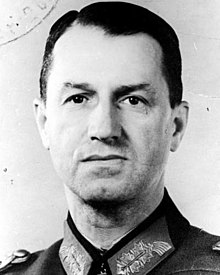Fritz Lindemann (11 April 1894 – 22 September 1944) was a German officer in the Wehrmacht of Nazi Germany and member of the resistance to Adolf Hitler.
Fritz Lindemann | |
|---|---|
 | |
| Born | 11 April 1894 Berlin-Charlottenburg, German Empire |
| Died | 22 September 1944 (aged 50) Berlin, Nazi Germany |
| Allegiance | |
| Service | Army |
| Rank | General of the Artillery |
| Commands | Artilleriekommandeur 138 132nd Infantry Division |
| Battles / wars | World War I World War II |
| Awards | Knight's Cross of the Iron Cross |
Career
editLindeman was born on 11 April 1894 in Berlin-Charlottenburg, a borough of the capital of the German Empire. His father was the son of Friedrich Lindemann, a military officer. In 1912, Lindemann graduated from the Viktoria-Gymnasium in Potsdam, present-day Helmholtz-Gymnasium Potsdam, receiving his Abitur (university entry qualification) at the top of his class.[1]
On request by the Foreign Minister of Germany, Ulrich von Brockdorff-Rantzau, Lindemann was selected as one of six officers providing security for the German delegation during the negotiation of Treaty of Versailles.[2]
After serving in World War I, Lindemann participated in the suppression of the German Revolution of 1918–1919 as a member of the Freikorps. However, as a member of the Reichswehr and a loyalist to the Weimar Republic, he refused to participate in the Kapp Putsch.[3]
Lindemann served as commander of the 132nd Infantry Division from January 1942 to August 1943, before appointment as Chief of Staff of the Artillery Oberkommando des Heeres.[3]
Lindemann developed contacts with conspirators against Adolf Hitler including General Helmuth Stieff, and following the assassination of Hitler it was proposed that he would read the conspirators' proclamation to the German people over the radio, but he did not appear at the Bendlerblock on 20 July 1944 in order to do so.[4] After the failure of the 20 July plot, he went into hiding. When the Gestapo came to arrest him, Lindemann tried to jump out of a window. However, he was shot in his leg and stomach, and later died in hospital from his injuries.
After standing trial for helping Lindemann at the People's Court, Erich and Elisabeth Gloeden, Hans Sierks and Carl Marks were all sentenced to death. They were executed by guillotine at Plötzensee Prison in September 1944.[5]
Awards and decorations
edit- Knight's Cross of the Iron Cross on 4 September 1941 as Oberst and Artilleriekommandeur 138.[6][Note 1]
- German Cross in Gold on 23 August 1942 as Generalmajor and commander of the 132. Infanterie-Division[8]
Notes
edit- ^ In absence from the proceedings, the fleeing Lindemann was deprived of all honors, ranks and orders and dishonourably discharged from the Heer on 4 August 1944, in connection with the 20 July plot, the failed attempt to assassinate Adolf Hitler. He died before his case was brought before the Volksgerichtshof (People's Court).[7]
References
editCitations
edit- ^ Welkerling 2011, p. 378.
- ^ Welkerling 2011, p. 379.
- ^ a b Museum, Stiftung Deutsches Historisches. "Gerade auf LeMO gesehen: LeMO Biografie". www.dhm.de (in German). Retrieved 2023-10-20.
- ^ Fest 1994, p. [page needed].
- ^ "The Nazi Party: The "People's Court" (1934 - 1945)". www.jewishvirtuallibrary.org. Retrieved January 26, 2020.
- ^ Fellgiebel 2000, p. 292.
- ^ Scherzer 2007, p. 155.
- ^ Patzwall & Scherzer 2001, p. 279.
Bibliography
edit- Bauer, Frank (1995). Sie gaben ihr Leben: Unbekannte Opfer des 20. Juli 1944, General Fritz Lindemann und seine Fluchthelfer; Chronos Publ.
- Bidermann, Gottlob Herbert (2000). In Deadly Combat: A German Soldier's Memoir of the Eastern Front; Univ. Press of Kansas Publ.
- Fellgiebel, Walther-Peer [in German] (2000) [1986]. Die Träger des Ritterkreuzes des Eisernen Kreuzes 1939–1945 — Die Inhaber der höchsten Auszeichnung des Zweiten Weltkrieges aller Wehrmachtteile [The Bearers of the Knight's Cross of the Iron Cross 1939–1945 — The Owners of the Highest Award of the Second World War of all Wehrmacht Branches] (in German). Friedberg, Germany: Podzun-Pallas. ISBN 978-3-7909-0284-6.
- Fest, Joachim (1994). Plotting Hitler's Death: The German Resistance to Hitler, 1933-1945. Weidenfeld & Nicolson. ISBN 978-0-297-81774-1.
- Patzwall, Klaus D.; Scherzer, Veit (2001). Das Deutsche Kreuz 1941 – 1945 Geschichte und Inhaber Band II [The German Cross 1941 – 1945 History and Recipients Volume 2] (in German). Norderstedt, Germany: Verlag Klaus D. Patzwall. ISBN 978-3-931533-45-8.
- Welkerling, Wolfgang (2011). "General der Artillerie Fritz Lindemann". In Ueberschär, Gerd R. (ed.). Hitlers militärische Elite [Hitler's Military Elite] (in German). Primus Verlag. pp. 378–386. ISBN 978-3-89678-727-9.
- Scherzer, Veit (2007). Die Ritterkreuzträger 1939–1945 Die Inhaber des Ritterkreuzes des Eisernen Kreuzes 1939 von Heer, Luftwaffe, Kriegsmarine, Waffen-SS, Volkssturm sowie mit Deutschland verbündeter Streitkräfte nach den Unterlagen des Bundesarchives [The Knight's Cross Bearers 1939–1945 The Holders of the Knight's Cross of the Iron Cross 1939 by Army, Air Force, Navy, Waffen-SS, Volkssturm and Allied Forces with Germany According to the Documents of the Federal Archives] (in German). Jena, Germany: Scherzers Militaer-Verlag. ISBN 978-3-938845-17-2.